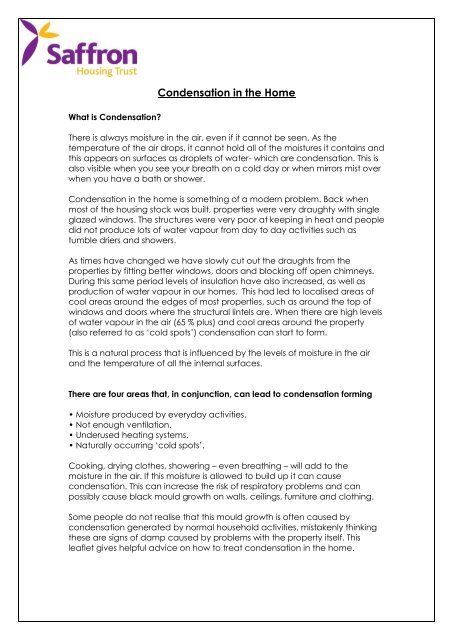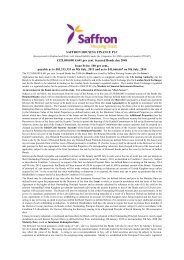Condensation Leaflet - Saffron Housing
Condensation Leaflet - Saffron Housing
Condensation Leaflet - Saffron Housing
Create successful ePaper yourself
Turn your PDF publications into a flip-book with our unique Google optimized e-Paper software.
What is <strong>Condensation</strong>?<br />
<strong>Condensation</strong> in the Home<br />
There is always moisture in the air, even if it cannot be seen. As the<br />
temperature of the air drops, it cannot hold all of the moistures it contains and<br />
this appears on surfaces as droplets of water- which are condensation. This is<br />
also visible when you see your breath on a cold day or when mirrors mist over<br />
when you have a bath or shower.<br />
<strong>Condensation</strong> in the home is something of a modern problem. Back when<br />
most of the housing stock was built, properties were very draughty with single<br />
glazed windows. The structures were very poor at keeping in heat and people<br />
did not produce lots of water vapour from day to day activities such as<br />
tumble driers and showers.<br />
As times have changed we have slowly cut out the draughts from the<br />
properties by fitting better windows, doors and blocking off open chimneys.<br />
During this same period levels of insulation have also increased, as well as<br />
production of water vapour in our homes. This had led to localised areas of<br />
cool areas around the edges of most properties, such as around the top of<br />
windows and doors where the structural lintels are. When there are high levels<br />
of water vapour in the air (65 % plus) and cool areas around the property<br />
(also referred to as ‘cold spots’) condensation can start to form.<br />
This is a natural process that is influenced by the levels of moisture in the air<br />
and the temperature of all the internal surfaces.<br />
There are four areas that, in conjunction, can lead to condensation forming<br />
• Moisture produced by everyday activities.<br />
• Not enough ventilation.<br />
• Underused heating systems.<br />
• Naturally occurring ‘cold spots’.<br />
Cooking, drying clothes, showering – even breathing – will add to the<br />
moisture in the air. If this moisture is allowed to build up it can cause<br />
condensation. This can increase the risk of respiratory problems and can<br />
possibly cause black mould growth on walls, ceilings, furniture and clothing.<br />
Some people do not realise that this mould growth is often caused by<br />
condensation generated by normal household activities, mistakenly thinking<br />
these are signs of damp caused by problems with the property itself. This<br />
leaflet gives helpful advice on how to treat condensation in the home.
If you live in a newly built house and have condensation or damp it maybe<br />
from the water used in its construction drying out-especially if the property<br />
was built during the winter months.<br />
How much airborne moisture can be produced in an average home in a<br />
day?<br />
<br />
<br />
<br />
<br />
<br />
<br />
Two people active for one day = 1.5 Litres<br />
Cooking and boiling a kettle = 3 Litres<br />
Having a bath or shower = 1 Litres<br />
Washing clothes = 0.5 Litres<br />
Drying clothes indoors= 4.5 Litres<br />
Using a paraffin or bottled gas heater = 1.5 Litres<br />
Looking at the figures above, it is possible that the amount of airborne<br />
moisture that can be produced in your home in one day could easily be<br />
around 12 Litres.<br />
There are many ways to tackle the problem:<br />
• Ventilate, or air, the home (do not over ventilate-having all of your<br />
windows wide open when it is cold outside will not help the problem and may<br />
make it worse)<br />
• Keep your home warm.<br />
• Wipe down surfaces where moisture settles.<br />
• Cover boiling pans when cooking.<br />
• When cooking, bathing or washing and drying clothes; close the kitchen<br />
and bathroom doors to prevent moist air entering colder rooms. Do not over<br />
ventilate these rooms-once the moisture has gone from the air close the<br />
windows and allow the rooms to warm up.<br />
• When cooking or washing, open windows or use extractor fans if fitted.<br />
• Cover fish tanks to stop the water evaporating into the air.<br />
• Dry clothes outside where possible.<br />
• Make sure tumble dryers are vented to the outside.<br />
• Do not use bottled gas or paraffin heaters as these produce a lot of<br />
moisture and can also be a health and safety risk if not used and stored<br />
appropriately. This is also in your tenancy agreement.<br />
• Where drying clothes inside is necessary, do so in a small room with windows<br />
open.<br />
• Open windows for a short while each day or use the trickle/night vents.
• Do not block air vents – this is also important where there are open flued<br />
gas and heating appliances present, as they need a constant supply of<br />
oxygen to work effectively and allow gases, such as carbon monoxide, to<br />
escape.<br />
• Allow air to circulate around furniture and in cupboards – you can do his by<br />
making sure cupboards and wardrobes aren’t overfilled and there is space<br />
between the furniture and the wall. Breather holes could also be cut into the<br />
back of wardrobes, for example, if clothes are attracting mould spores.<br />
Keep your home warm:<br />
• When the whole house is warmer, condensation is less likely to form.<br />
• Insulating your loft and walls will help. If yours are not insulated, contact us<br />
on 01508 532000 for details of works planned for your area or advice on<br />
energy efficiency.<br />
• Maintain a low, constant, level of heating when the weather is cold or wet –<br />
this is more effective than short bursts of high heat.<br />
Important things to remember:<br />
• Do not block permanent ventilators.<br />
• Do not put furniture against cold external walls.
What to do if your home is already suffering mould:<br />
The tips set out above should help prevent mould, but what if you already<br />
have the problem?<br />
How do you get rid of it?<br />
• Do not disturb mould by brushing or vacuum cleaning.<br />
This can increase the risk of respiratory problems by releasing spores.<br />
• Mould is a living organism and needs killing to get rid of it. To do this, wipe<br />
down affected areas with a fungicidal wash – one which carries a Health and<br />
Safety Executive approved number – making sure you follow the<br />
manufacturer’s instructions.<br />
Fungicidal Wash<br />
Do not use Bleach or Washing up liquid!<br />
This may temporarily have an effect, but may end up<br />
promoting mould growth in the future.<br />
• Treat any mould you may already have in your home,<br />
and then follow the advice in this leaflet to reduce<br />
condensation. This will restrict new mould growth.<br />
• Mildewed clothes should always be dry cleaned and<br />
any affected carpets shampooed.<br />
• After treatment, redecorate using a good quality antifungicidal<br />
paint to help prevent mould recurring. Please note that antifungicidal<br />
paint loses its effectiveness if overlaid with ordinary paints or<br />
wallpapers.
• Even after treatment, depending on the humidity in the dwelling, it may not<br />
be possible to eliminate all mould patches in some of the more troublesome<br />
spots.<br />
The corners on external walls, for example, are more susceptible to mould<br />
growth when high levels of airborne moisture are present. This is because<br />
these areas lose energy much quicker than the straight sections of wall. This<br />
makes the surface of the corners cooler, allowing condensation to form.<br />
Another problem area is the surface of glazing & window frames (even<br />
double glazing). As the frame and the surface of the glass can be cooler<br />
than the surrounding elements, it can have the same effect as with a cold<br />
glass of beer on a summer’s day-condensation forming on it surface.<br />
I have followed the advice in this leaflet, what do I do next?<br />
If you have followed the advice given in this leaflet, then you should begin to<br />
notice a considerable improvement within a few weeks (possibly longer<br />
during a cold winter). If the problem persists, it may possibly be due to<br />
another cause of damp. There are four main causes of damp;<br />
• <strong>Condensation</strong> – as discussed in this leaflet<br />
• Rising damp – this is usually very rare as a damp proof course prevents this,<br />
but it can usually be seen by a tide mark above the skirting board.<br />
• Penetrating damp – Usually caused by damage or a problem with the<br />
fabric of the building which means rainwater is able to find its way through<br />
the walls, roof, windows or doors etc.<br />
• Plumbing faults or broken leaking pipes<br />
Rising damp and penetrating damp can be difficult to identify at the early<br />
stages. A leaking pipe can be more difficult to identify, and if you suspect you<br />
may have a leaking pipe then this should be reported to the Repairs team on<br />
01508 532060 as soon as possible.<br />
If you have not seen obvious improvement after following our advice, or you<br />
suspect a more serious cause of damp, please contact us on 01508 532000<br />
and a damp inspection will be organised.











